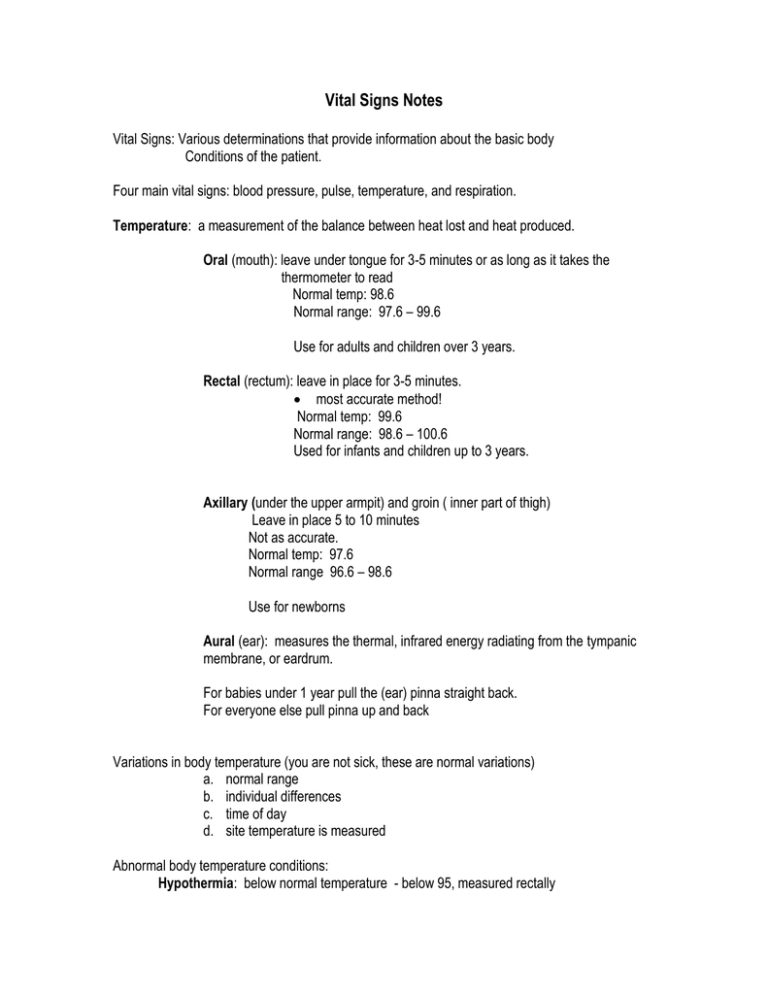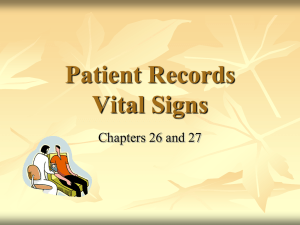Vital Signs Notes
advertisement

Vital Signs Notes Vital Signs: Various determinations that provide information about the basic body Conditions of the patient. Four main vital signs: blood pressure, pulse, temperature, and respiration. Temperature: a measurement of the balance between heat lost and heat produced. Oral (mouth): leave under tongue for 3-5 minutes or as long as it takes the thermometer to read Normal temp: 98.6 Normal range: 97.6 – 99.6 Use for adults and children over 3 years. Rectal (rectum): leave in place for 3-5 minutes. most accurate method! Normal temp: 99.6 Normal range: 98.6 – 100.6 Used for infants and children up to 3 years. Axillary (under the upper armpit) and groin ( inner part of thigh) Leave in place 5 to 10 minutes Not as accurate. Normal temp: 97.6 Normal range 96.6 – 98.6 Use for newborns Aural (ear): measures the thermal, infrared energy radiating from the tympanic membrane, or eardrum. For babies under 1 year pull the (ear) pinna straight back. For everyone else pull pinna up and back Variations in body temperature (you are not sick, these are normal variations) a. normal range b. individual differences c. time of day d. site temperature is measured Abnormal body temperature conditions: Hypothermia: below normal temperature - below 95, measured rectally Death usually occurs if temperature falls below 93 for a period What causes body temperature to decrease: starvation or fasting, sleep, decreased muscle activity, exposure to cold. Hyperthermia: when body temperature exceeds 104 rectally. Temp over 106 can for a period of time can lead to convulsions and death. Temp over 101 = fever What caused body temps to rise? Infection, injury, muscle and gland activity, food metabolism Pyrexia or Febrile: Fever is present Afebrile: No fever present Homeostasis: a constant state of fluid balance. If a body temperature is too high or too low, the body’s fluid balance is affected. How is heat lost? Perspiration, respiration, excretion (urine, feces) If a patient has been eating, drinking or smoking, this will alter the oral temp. Wait 15 minutes before rechecking a temperature. Pulse: The pressure of the blood felt against the wall of an artery as the heart beats. How do you describe the pulse? Rate – number of beats per minute Rhythm – is it regular or irregular Volume – is it strong, weak, thready or bounding Normal range for pulse: Adults: 60 – 100 bpm (beats per minute) Children over 7 years: 65-80 bpm Children 1 – 7 years: 80 – 110 bpm Infants: 100 – 160 bpm A rate under 60 bpm is bradycardia. This can be caused by sleep, depressant drugs, cold, heart disease, and coma A rate over 100 bpm is Tachycardia. This can be caused by exercise, drugs, fever, heat, obesity, emotional state (nervousness, fear, anxiety) When measuring a pulse, DO NOT use your thumb! The thumb contains a pulse that you may confuse with the patient’s pulse. Apical Pulse: a pulse taken with a stethoscope placed at the apex of the heart. Who do take an apical pulse on? People with heart disease, infants, children, initial assessment Respirations: The process of taking in oxygen and expelling carbon dioxide Normal ranges: Adults: 12 – 24 Children: 16 – 30 Infants: 30 – 50 1 inspiration + 1 expiration = respiration How do you describe respirations? Rate – number of times a person breathes per minute Character – refers to the depth and quality of respirations Ex. Deep, shallow, labored, difficult, striderous, and moist Rhythm – refers to the regularity or respirations. EX. Regular or irregular Why should the patient not be aware when you are counting respirations? If the patient is aware, they can alter their respiration. Abnormal respirations Dyspnea: difficult or labored breathing Apnea: absence of respirations Cheyne-stokes – periods of dyspnea followed by periods of apena Rales: bubbling or noisy sounds caused by fluid in the lungs Tachypnea – abnormal respiratory rate >24 Bradypnea – below normal respiratory rate <12 Wheezing – high pitched noise caused by air being forced through swollen bronchioles Blood Pressure: a measurement of the pressure that the blood exerts on the walls of the arteries during the various stages of heart activity. Read in millimeters (mm) of mercury (Hg) on an instrument known as a sphygmomanometer Systolic pressure – occurs in the walls of the arteries when the heart is contracting and pushing blood into the arteries. Normal systolic 120 mmHg Normal range 100 – 140 mm Hg Diastolic pressure – the constant pressure in the walls of the arteries when the heart is at rest, or between contractions. Normal diastolic is 80 mm Hg Normal range 60 – 90 mm Hg Increased BP can be caused by excitement, stimulant drugs, exercise, eating Decreased BP can be caused by rest, sleep, depressant drugs, shock, and blood loss Take while : Seated comfortably or lying Quiet 5 minutes prior Place cuff of proper size cuff Forearm supported on flat surface at heart level Over brachial artery 1-1 1/2” above antecubital area Place stethoscope securely over brachial artery.



